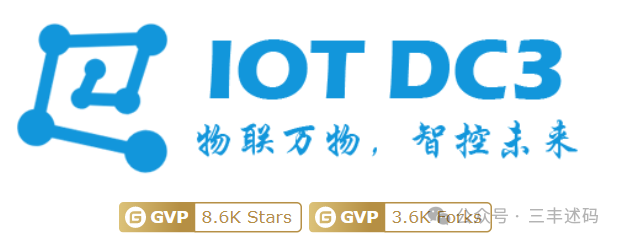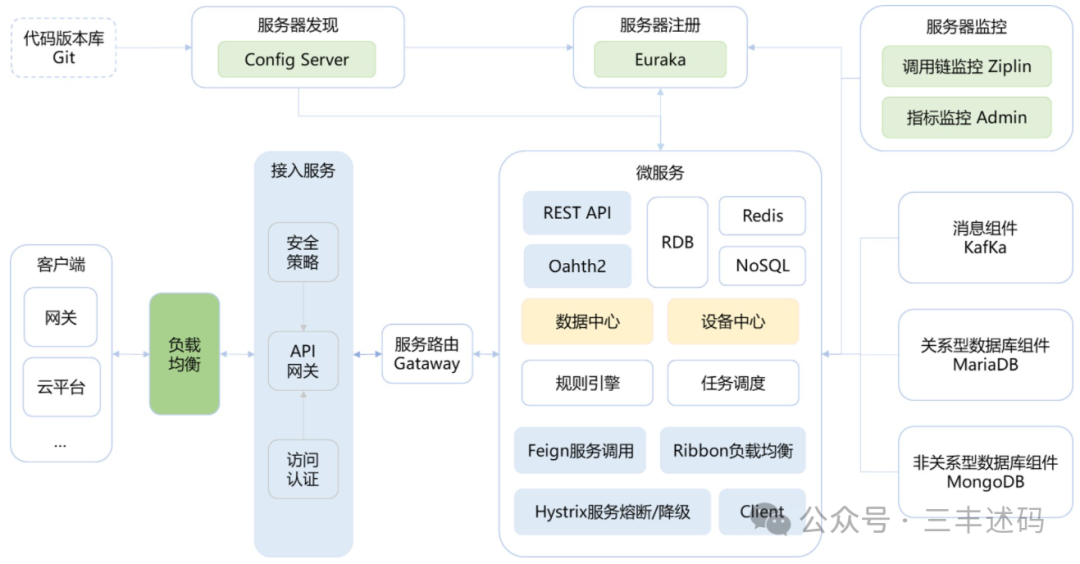Introduction
IoT-DC3 is an open-source IoT platform, fully known as “Internet of Things – Data Collection and Control Center”. It aims to provide solutions for data collection, storage, analysis, and device management in IoT projects. The IoT-DC3 platform helps developers quickly build IoT applications, supporting various device protocols and data formats, with the following features:
-
Multi-protocol support: IoT-DC3 supports common IoT communication protocols such as MQTT, HTTP, TCP, UDP, etc., enabling communication with various devices and sensors.
-
Data collection and storage: The platform can collect device data and store it in databases, supporting various database systems like MySQL, InfluxDB, TimescaleDB, etc.
-
Real-time data processing: IoT-DC3 can perform real-time processing and analysis on the collected data, supporting operations such as data filtering, transformation, and computation.
-
Device management: The platform offers functions like device registration, status monitoring, and control, making it easy for users to manage IoT devices.
-
Scalability: IoT-DC3 is designed with scalability in mind, allowing new functional modules to be added or third-party services to be integrated based on project requirements.
-
Open-source and free: IoT-DC3 is open-source software, allowing users to use and modify the source code for free to meet their needs.
-
Easy deployment: The platform supports various deployment methods, including containerized deployment (like Docker) and cloud service deployment, simplifying the deployment process.
IoT-DC3 is suitable for various IoT application scenarios, such as smart homes, industrial automation, environmental monitoring, and smart cities, helping companies and developers build stable and reliable IoT solutions. Being open-source and with an active community, it continuously evolves with new features and improvements.

Architecture Design

-
Driver layer: Provides an SDK for connecting physical devices using standard or proprietary protocols, responsible for data collection and command control from southbound devices, enabling rapid development of drivers based on the <span>SDK</span>. -
Data layer: Responsible for collecting device data and storing it, providing data management interface services. -
Management layer: Provides a microservices registry, device command interface, device registration and pairing, and data management center, which is the core part of all microservices interaction, managing various configuration data and providing interface services externally. -
Application layer (partially completed): Provides data openness, task scheduling, alerts and notifications, log management, and has the capability to integrate with third-party platforms.
-
Scalable: A horizontally scalable platform built using leading <span>Spring Cloud</span>open-source technology. -
Fault tolerance: No single point of failure; each node in the cluster is identical. -
Robust and efficient: A single server node can handle hundreds or thousands of devices depending on the use case. -
Customizable: Add new device protocols and register them with the service center. -
Cross-platform: Can be deployed in distributed multi-platform environments using <span>Java</span>. -
Self-controllable: Private cloud, public cloud, edge deployment. -
Completeness: Rapid device access, registration, and permission verification. -
Security: Data encryption during transmission. -
Multi-tenant: Namespaces, multi-tenancy. -
Cloud-native: Kubernetes. -
Containerized: Docker.

As an open-source IoT platform, IoT-DC3 can be applied to various scenarios. Here are some typical application scenarios:
-
Smart Home: Through the IoT-DC3 platform, remote monitoring and control of home devices such as smart bulbs, smart sockets, smart locks, and temperature and humidity sensors can be achieved.
-
Industrial Automation: In industrial production lines, IoT-DC3 can be used to collect machine operation data, monitor device status, optimize production processes, and improve production efficiency.
-
Environmental Monitoring: Used to monitor environmental parameters such as air quality, water quality, soil moisture, and meteorological data, aiding in environmental management and protection.
-
Smart Agriculture: By monitoring environmental conditions in fields such as soil moisture, temperature, and light using IoT-DC3, precise irrigation and fertilization can be achieved to increase crop yield.
-
Energy Management: In building automation systems, IoT-DC3 can monitor energy consumption, such as electricity, water, and gas, helping enterprises or households achieve energy savings.
-
Logistics and Supply Chain Management: Using IoT-DC3 to track the location, status, and environmental conditions of goods during logistics processes, improving logistics efficiency and management levels.
-
Smart City: In smart city projects, IoT-DC3 can be used for urban management, such as traffic flow monitoring, public safety, and infrastructure maintenance.
-
Healthcare: By monitoring patients’ vital signs such as heart rate and blood pressure through IoT-DC3, remote medical monitoring and health management can be achieved.
-
Retail: In retail environments, IoT-DC3 can be used for inventory management, customer behavior analysis, and smart shelves.
-
Security Monitoring: Using IoT-DC3 to implement security monitoring functions such as video surveillance, intrusion detection, and fire alarms.
-
Asset Management: In enterprises, IoT-DC3 can be used to track and manage fixed assets such as office equipment and vehicles.
-
Remote Maintenance: Through the IoT-DC3 platform, monitoring and maintenance of remote devices can be achieved, reducing on-site maintenance costs.
These application scenarios demonstrate the flexibility and versatility of IoT-DC3, which can be customized according to different business needs to adapt to various IoT solutions.
Open-source Address
Follow the public account and reply 20241225 to obtainYou may also like:
[Open Source] Local Knowledge Base Q&A System Supporting Any Format Files or Databases, Can Be Installed and Used Offline.
Smart Park Management System: AIoT Empowerment, Creating a New Type of Smart Park
[Open Source] No-Code Design Concept, Providing Businesses with “Free” Form Questionnaire Capabilities, “Out of the Box” Rapid Empowerment of Business
[Open Source] A Web-Based Open Source User Support/Ticket Management System Aimed at Helping Teams Manage and Coordinate Customer Communications from Multiple Channels.
[Open Source] Inventory Management PSI and Warehouse Management System WMS for SMEs, Allowing Addition of Regular Functions without Writing Any Code, Also Supporting Efficient Development of Complex Functions.
Join WeChat for related group discussions,
Note “Microservices” to enter the group for discussions
Note “Low Start” to enter the low start group for discussions
Note “AI” to enter the AI big data and data governance group for discussions
Note “Digital” to enter the IoT and digital twin group for discussions
Note “Security” to enter the security-related group for discussions
Note “Automation” to enter the automation operation and maintenance group for discussions
Note “Trial” to apply for product trial
Note “Channel” for cooperation channel information
Note “Customization” to customize projects with full source code delivery
